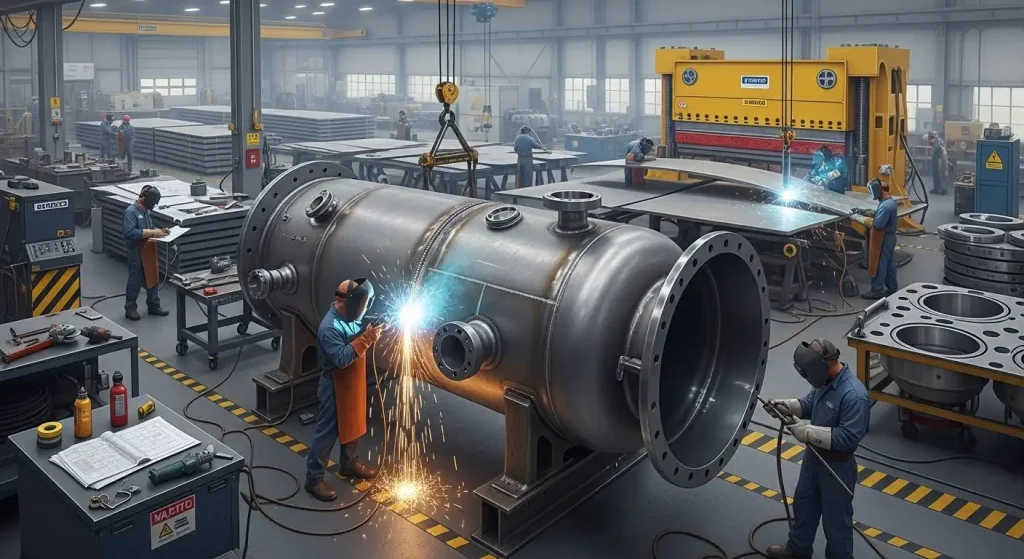
## Keeping the Oil and Gas Flowing: The Vital Role of Surface Facilities Maintenance
The oil and gas industry relies on a complex network of infrastructure, both above and below ground, to extract, process, and transport hydrocarbons. While drilling and well completion often grab headlines, the efficient and reliable operation of **surface facilities** is just as crucial for maintaining production and ensuring safety. These facilities, encompassing everything from wellheads to processing plants, require rigorous and proactive maintenance to keep the lifeblood of the energy industry flowing smoothly.
**What are Surface Facilities?**
Surface facilities are the visible and tangible infrastructure that connect the wellbore to the end consumer. They include a vast array of equipment, such as:
* **Wellheads:** The interface between the well and the surface, controlling flow and pressure.
* **Separators:** Vessels that separate oil, gas, and water after they are extracted.
* **Compressors:** Used to increase the pressure of natural gas for transportation.
* **Pumps:** Move fluids through pipelines and processing facilities.
* **Storage Tanks:** Hold crude oil, natural gas liquids (NGLs), and other products.
* **Pipelines:** Transport hydrocarbons over long distances.
* **Processing Plants:** Refine and treat raw hydrocarbons to meet market specifications.
* **Metering and Control Systems:** Monitor and regulate flow rates, pressures, and other critical parameters.
**Why is Maintenance so Critical?**
Neglecting maintenance on these facilities can lead to a cascade of negative consequences, including:
* **Production Downtime:** Equipment failure can halt production, resulting in significant financial losses.
* **Safety Hazards:** Leaks, spills, and explosions can endanger workers, communities, and the environment.
* **Environmental Damage:** Releases of hydrocarbons can contaminate soil, water, and air.
* **Equipment Degradation:** Corrosion, erosion, and other forms of wear and tear can shorten the lifespan of equipment and increase replacement costs.
* **Regulatory Non-Compliance:** Failure to meet safety and environmental regulations can result in fines and penalties.
**Types of Maintenance Strategies:**
Effective surface facilities maintenance relies on a combination of different strategies:
* **Preventive Maintenance (PM):** Regularly scheduled inspections, lubrication, cleaning, and component replacements based on time intervals or operating hours. PM aims to prevent failures before they occur.
* **Predictive Maintenance (PdM):** Uses advanced technologies like vibration analysis, infrared thermography, and ultrasonic testing to monitor equipment condition and predict potential failures. This allows for proactive intervention before a breakdown occurs.
* **Corrective Maintenance (CM):** Repairs or replacements performed after a failure has occurred. While unavoidable, CM should be minimized through effective PM and PdM programs.
* **Reliability-Centered Maintenance (RCM):** A comprehensive approach that analyzes the potential failure modes of each piece of equipment and develops a maintenance strategy based on the criticality of the equipment and the consequences of failure.
**Best Practices for Surface Facilities Maintenance:**
Implementing a robust maintenance program requires adherence to industry best practices:
* **Develop a Comprehensive Maintenance Plan:** This plan should outline specific maintenance tasks, schedules, and procedures for each piece of equipment.
* **Utilize a Computerized Maintenance Management System (CMMS):** A CMMS helps track maintenance activities, manage inventory, schedule work orders, and analyze maintenance data.
* **Invest in Training:** Ensure that maintenance personnel are properly trained on the operation and maintenance of all equipment.
* **Implement a Robust Inspection Program:** Regular inspections can identify potential problems early on, allowing for timely intervention.
* **Focus on Corrosion Control:** Corrosion is a major threat to surface facilities. Implement corrosion prevention measures such as coatings, cathodic protection, and chemical inhibitors.
* **Prioritize Safety:** Safety should be the top priority in all maintenance activities. Ensure that all personnel are properly trained on safety procedures and that appropriate personal protective equipment (PPE) is used.
* **Continuously Improve:** Regularly review maintenance data and identify areas for improvement.
**The Future of Surface Facilities Maintenance:**
The oil and gas industry is increasingly adopting new technologies to improve the efficiency and effectiveness of surface facilities maintenance. These technologies include:
* **Drones:** Used for remote inspections of pipelines, tanks, and other facilities.
* **Robotics:** Used for cleaning, inspection, and repair tasks in hazardous environments.
* **Artificial Intelligence (AI) and Machine Learning (ML):** Used to analyze maintenance data, predict equipment failures, and optimize maintenance schedules.
* **Digital Twins:** Virtual representations of physical assets that can be used to simulate operating conditions and predict performance.
**Conclusion:**
Maintaining surface facilities is a critical aspect of the oil and gas industry. By implementing a proactive and comprehensive maintenance program, operators can minimize downtime, improve safety, protect the environment, and extend the lifespan of their assets. As the industry continues to evolve, embracing new technologies and best practices will be essential for ensuring the long-term sustainability and reliability of surface facilities. The consistent and dedicated focus on maintenance is what keeps the oil and gas, and the energy industry, flowing.